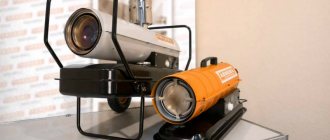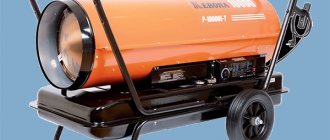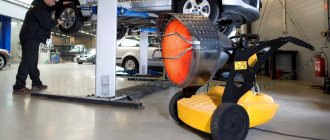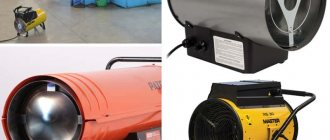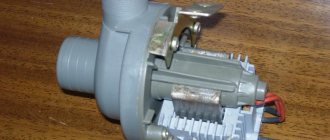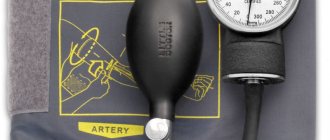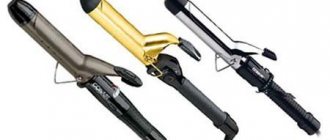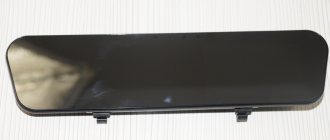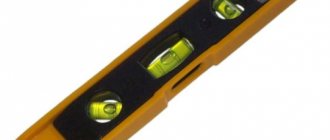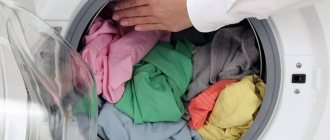Heat guns are high-power heating devices that are used to heat indoor air or create comfortable heat flows outdoors (for various purposes).
Heat guns are divided according to the type of energy used to heat the air:
- electrical;
- diesel;
- gas;
Diesel and gas are also divided into:
- direct action;
- indirect action.
Direct action heat guns
Direct-acting heat guns are used only in well-ventilated rooms and outdoors, due to the principle of their operation.
And the operating principle is based on the combustion of a flammable substance (in this case, diesel fuel) in a special chamber, which ensures its complete combustion. The efficiency of direct heating heat guns is close to 100 percent, but heating occurs with combustion products containing a high content of carbon dioxide and harmful substances.
The combustible substance is supplied to the combustion chamber from the fuel tank by a pump or using an air compressor, which creates a vacuum in the area of the nozzle with a jet of air, which (the vacuum) is enough to lift diesel fuel from the tank (atomizer principle).
Unlike their gas and electric counterparts, diesel heat guns have a fuel supply system, which complicates the system and makes it more expensive. Diesel fuel can be contaminated with impurities and foreign matter, so the power system requires routine maintenance and filters (if any) need to be replaced.
BISON gun "MASTER" thermal, gas, 10.0 kW, TPG-10000_M2
Diesel heat guns are quite efficient and remain an indispensable means of heating in some situations in which it is impossible (or undesirable) to use other types of heaters.
Transportation of diesel fuel is more convenient and safer than gas cylinders (which need to be stored, refueled, transported somewhere), and connecting an electric heat gun of comparable power and comparable efficiency can be problematic.
A full tank of a diesel heat gun (depending on the power and intensity of operation) is enough for 10-15 hours of continuous operation, and a solid fuel supply (up to 50 liters or more) allows you to fill it once per shift.
How does a diesel heat gun work?
In this article we will look at the design and operating principle of a diesel heat gun , and also find out for what purpose this unit is used and what its advantage is. A heat gun for rent, powered by diesel fuel, is a heating equipment that is designed to solve the following problems:
- rapid heating of non-residential premises with a large area - greenhouses, warehouses, hangars for storing agricultural equipment;
- heating greenhouses and greenhouses for growing various crops;
- creating optimal temperature conditions on unheated construction sites;
- suspended ceiling devices;
- as an additional source of heat in garages.
It should be noted right away that this type of heating equipment is not intended for use in residential buildings, since combustion products will enter the room during use.
Diesel heat guns for indirect heating
Diesel heat guns of indirect heating allow the use of these heaters in rooms with people and animals, since the toxic exhaust is discharged separately. An additional heating circuit allows you to separate the flow of clean heated air and hot exhaust gases.
The exhaust pipe is located at the top of the heat gun and allows you to connect a fire-resistant hose to discharge combustion products to the street or into the chimney.
Clean air is pumped by a fan through the heating chamber, which is heated from the outside by a flame of combusted diesel fuel. The efficiency of indirectly heated diesel heat guns is naturally lower than that of direct heated diesel heat guns, but remains quite high.
For the operation of power systems, automatic ignition, fans, and protection systems, mains (or any other) electrical voltage is required.
Electrical energy consumption is mainly required to operate an electric fan (usually of low power 50-200 Watts),
piezo ignition or spark plugs.
If mains electricity is unavailable, diesel heat guns can be powered from a generator or battery with an inverter (a device that converts the battery's 12 Volt DC into 220 Volt AC).
An automated control system allows diesel (and other) heat guns to operate without human intervention, that is, a built-in thermostat that controls the ambient temperature issues a command to turn off or ignite the heating equipment.
To avoid emergency situations, heating devices are equipped with a protection system when the fan stops, which reacts to an increase in temperature in the combustion chamber and shuts off the fuel supply.
In more complex models, rollover sensors, oxygen control in the air, flame attenuation, etc. may be installed.
Thermal gun BISON "MASTER" COMPACT ZTP-M1-5000
Features of diesel indirect heating heat guns for the garage, prices and reviews
This type of gun functions in much the same way as direct fired designs. The only difference is that the combustion products that are formed during the process of fuel exhaustion are removed outside the room. A chimney is used for this. Thanks to this, indirect heating guns can be used in almost any room with a sufficient level of ventilation.
Powerful heat guns have impressive dimensions and are used to heat large areas
A nozzle is installed in the design of the closed combustion chamber. In addition, the gun has a system designed to remove combustion products. The air pumped by the fan does not come into contact with the torch. Its heating is provided by blowing into the combustion chamber.
Average prices of indirectly heated diesel heat guns:
| Brand | Model | Power level, kW | price, rub. |
| Profteplo | DK-21N | 21 | 29930 |
| DK-21R | 21 | 32250 | |
| DK-21N-R | 21 | 44920 | |
| Kroll | MAK 15 | 15 | 34350 |
| MAK 25 | 26 | 41180 | |
| MAK 40 | 38,5 | 44500 | |
| Aurora | TK-55 ID | 17,5 | 37400 |
| TK-80K ID | 25 | 43400 | |
| TK-240K ID | 70 | 70200 |
Helpful advice! The thermal power of a device for heating a room can be determined using this formula: Q (in kcal/h) = K × V × ΔT, where Q is the required level of thermal power, K is a coefficient reflecting the degree of heat dissipation, V is the total volume of the room, and ΔT is the difference between the outside temperature and the one required to create a comfortable indoor microclimate.
Heat guns are often used to heat tents during the cold season
Consumer opinion about diesel heat guns: reviews of indirect heating designs
Reviews from forums about indirect heating guns:
“I use the KROLL MAK15 gun and am completely satisfied with this unit. No more than 1.5 liters of diesel fuel is consumed per hour in maximum operating mode. It was the efficiency that attracted me to this model. The tank is designed for 30 liters. In the winter, I only use winter diesel, otherwise the fuel just settles. There are no problems with starting."
Evgeny Doroshenko, St. Petersburg
“After an accident on the heating main, which provided heating in the garage, we had to buy a Master BV77E diesel heat gun. The unit is, of course, large. The length of the body exceeds 1 m, and the weight of the structure with an empty tank is neither more nor less than 55 kg. Fortunately, the manufacturer provided the possibility of convenient transportation, which I could not help but appreciate. The device comes with a trolley on wheels. The construction is quite durable. After 3 months, no breakdowns, backlashes or extraneous sounds. The only thing I don't like is the need to constantly check the fuel. Yes, and filters need to be changed from time to time. Otherwise the device is great.”
Konstantin Nalivaiko, St. Petersburg
Indirect heating guns require an air duct through which warm heated air enters the room
Gas heat guns
Gas heat guns are simpler than diesel ones due to the lack of fuel supply and filtration systems, so their price is much lower.
Combustible gas is supplied under pressure from a gas cylinder or line, which is why some models of gas heat guns are supplied with gas reducers.
When gas burns, not a lot of harmful substances are released, so gas heat guns of even high power (70 kW or more) are found in a direct version, that is, without exhaust removal (but provision of air access and ventilation are stipulated).
When operating gas heat guns, do not forget that at low temperatures, the evaporation of gas in the cylinders slows down greatly and the pressure may not be enough to start the automatic heating device.
The minimum operating gas pressure is within 0.5 bar.
The automation system monitors the temperature in the burner area and, when the flame dies out, tries to ignite it again (up to three times), and if the flame does not ignite, it shuts off the gas supply.
Gas heat guns are quite efficient heating devices (up to 100 kW and above), and the ability to use 100 percent efficiency makes these units, in some conditions, the best choice.
How to choose a diesel heat gun (2018)
Diesel heat guns can help if electric and gas heat guns are not suitable for one reason or another: among diesel guns there are models that can safely heat living spaces, and their maximum heating power reaches 200 kW.
However, diesel heat guns also have disadvantages: high price - in terms of kilowatt of thermal power, diesel guns are noticeably more expensive than both electric and gas ones; expensive fuel - with similar specific fuel consumption per kilowatt of power, the fuel itself costs 1.5-2 times more than gas; Directly heated diesel guns have a “dirtier” exhaust than gas guns - the requirements for ventilation of heated rooms when using diesel guns are higher.
Electric heat guns
An example of an electric heat gun is a hair dryer, but it is not intended for long-term use.
If it is possible to connect to the electrical network with sufficient power, electric guns will be preferable to their diesel and gas counterparts.
To connect electric heat guns up to 5 kW, a single-phase 220 Volt network is sufficient; when connecting more powerful electrical appliances, a three-phase 380 Volt network is used.
Wires made of alloys with high resistance and different cross-sectional geometries are used as heating elements.
A heating element is a tubular electric heater made in a closed form; a nichrome wire is placed inside the tube, where high-temperature dielectrics are used as an insulator. When opened, it is a wire (nichrome or fechrome) twisted into a spiral, located on ceramic insulators.
Electric heat guns are easy to use, easy to manufacture, easy to adjust, inexpensive, and quite safe.
ZUBR "EXPERT" "Square" thermal electric gun ZTPE-24000-F_M2
Negative factors include the high cost of electricity and the incompatibility of electrical appliances with moisture, dampness and water, in any form.
Electric heat guns are produced in a fireproof design, and the use of heating elements makes them even safer.
With proper connection, operation and use of residual current devices (RCDs), electric heating devices can be considered the simplest and most comfortable to use.
Operating rules
Heat guns of any design (electric, gas, diesel) are not allowed to be covered, as this leads to disruption of air circulation and overheating.
Heat guns cannot be used in cramped conditions, that is, direct the air flow towards an obstacle, which also leads to disruption of air circulation.
Ventilation and access to fresh air are a prerequisite for the operation of powerful heating devices, since heat guns burn oxygen.
When using heat guns in production or construction, it is necessary to take into account that heavy dust levels lead to failure or fire hazard.
Before putting it into operation for the first time, read the manufacturer's instructions and follow its recommendations.
